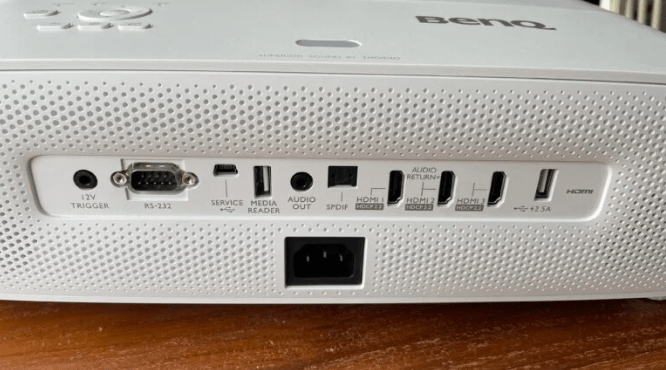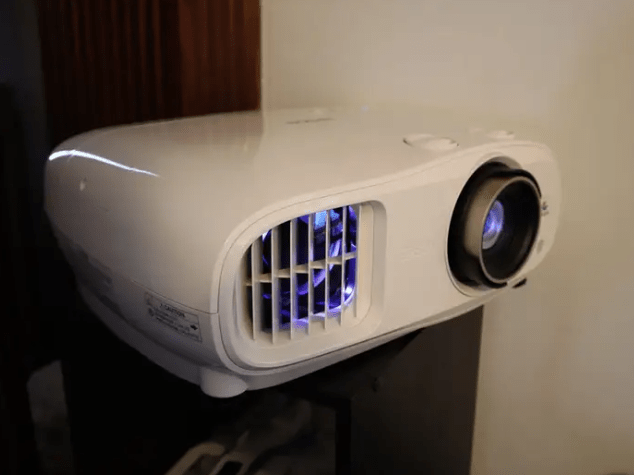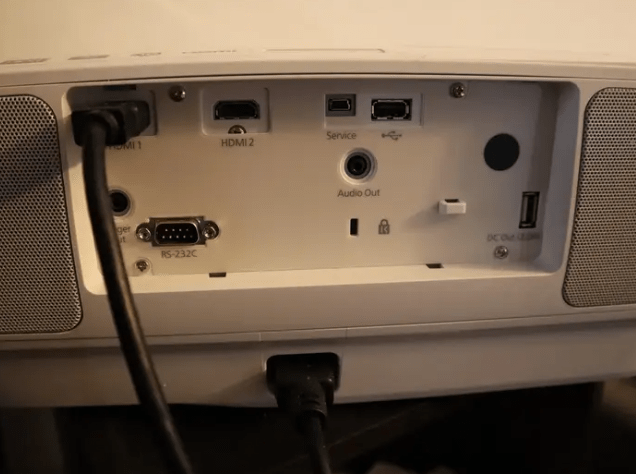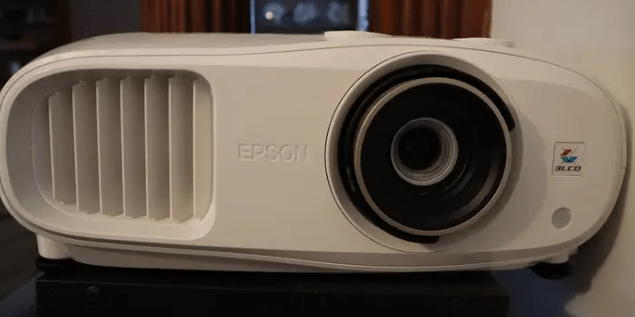At gagadget.com, your trust is our priority. We follow strict quality standards in our research, tests, and analysis of video projectors, to give you the best experience. Learn more
BenQ TK860i vs Epson 3800
Hey everyone, it's Jim from Gagadget. Today, I'm comparing two feature-packed 4K projectors: the BenQ TK860i and the Epson 3800. While both deliver stunning big screen experiences with the latest 4K HDR tech, they differ in key areas like light output, contrast, smart features, and more.
I've spent quality time with both projectors, evaluating picture quality, ease of use, gaming performance, and overall value. In this in-depth head-to-head, I'll highlight how they stack up in the most important aspects for home theater. By the end, you'll have a clear idea which one is the better fit for your setup and viewing habits. Let's dig in!
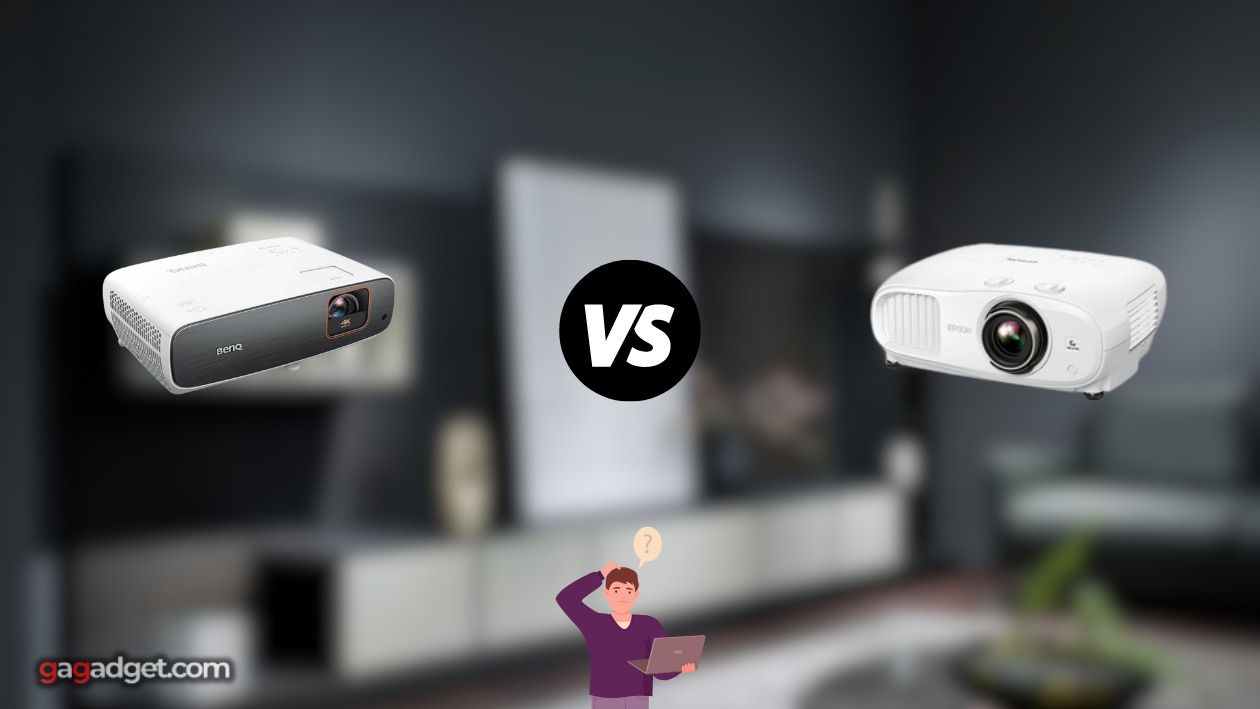
BenQ TK860i vs Epson 3800: Quick Overview
Here are the key takeaways for those short on time: The BenQ TK860i and Epson 3800 are both highly capable 4K projectors for home theater. They share similar brightness at around 3,000 lumens, HDR10 and HLG support, 3D capability, and excellent input lag for gaming under 30ms. The TK860i has the edge in native contrast at 50,000:1 vs the 3800's 100,000:1 dynamic ratio. It also adds smart features like Android TV and Google Assistant. The 3800 counters with a more generous zoom range, wider lens shift, and a dynamic iris.
I recommend the BenQ TK860i for users who want the absolute latest in smart projector tech and don't need quite as much installation flexibility. Its higher native contrast, integrated streaming, and newer processing deliver a punchier, more future-proof experience. But if you require the placement versatility of a wide zoom and lens shift, or want to maximize bang-for-the-buck, the Epson 3800 remains an excellent, highly customizable alternative.
Table of Contents
- BenQ TK860i vs Epson 3800: Full Comparison
- Epson 3800 vs BenQ TK860: Design
- BenQ TK860i or Epson 3800: Owner Reviews
- BenQ TK860i and Epson 3800 Alternatives
- Which Projector Should You Buy?
Epson 3800 vs BenQ TK860i: Comparison Table
| Specs | BenQ TK860i | Epson 3800 |
| Image |
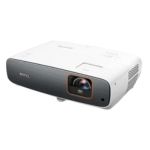
|
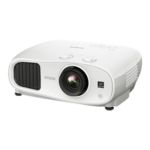
|
| Native Resolution | 3840 x 2160 (4K UHD) | 1920 x 1080 w/4K pixel shifting |
| Brightness | 3,300 lumens (ANSI) | 3,000 lumens (ISO) 3,000 lumens (CLO) |
| Contrast | 50,000:1 (native) | 100,000:1 (dynamic) |
| Display Type | DLP 0.47" DMD | 3LCD 0.61" (D8) |
| Input Lag | 4K/60: 17.9ms 1080p/60: 17.9ms 1080p/120: 21ms 1080p/240: 8.7ms |
4K/60: 20.6ms 1080p/60: 28ms |
| Zoom/Lens Shift | 1.3x manual zoom +10% vertical lens shift |
1.62x manual zoom +/- 60% vertical +/- 24% horizontal |
| Lamp Life (Normal/Eco) | 4,000 / 15,000 hours | 3,500 / 5,000 hours |
| Audible Noise | 30 dB (Normal) 28 dB (Eco) |
35 dB (Normal) 24 dB (Eco) |
| Built-in Speakers | 5W x 2 (TreVolo) | 10W x 2 |
| Smart Features | Android TV Google Assistant Streaming apps |
None |
| Connectivity | HDMI 2.0 x3 USB x3 RS-232C Optical audio out |
HDMI 2.0 x2 USB x2 RS-232C 3.5mm audio out Wi-Fi adapter port |
| Dimensions (W x D x H) | 14.9" x 10.3" x 5.1" | 16" × 13" × 6.5" |
| Weight | 9.3 lbs | 15.2 lbs |
| Release Year | 2023 | 2019 |
Starting with picture quality, both the BenQ TK860i and Epson 3800 serve up crisp, colorful 4K images with good HDR performance. The TK860i has the advantage of a native 4K DLP chip vs the 3800's pixel-shifted 1080p LCD panel. In a side-by-side comparison, I did observe slightly better fine detail clarity and edge sharpness on the BenQ, especially in bright scenes. But from a normal viewing distance, the difference is subtle at best.
The BenQ's higher 50,000:1 native contrast ratio also gave it an edge in image depth and pop vs the Epson's 100,000:1 dynamic figure. Blacks looked a touch inkier and highlights had more sparkle, particularly in dimmer viewing environments. The 3800's 12-bit processing and 3LCD design still produce excellent contrast, but the dynamic iris causes some noticeable black level pumping in dark-to-bright scene transitions.
In terms of HDR, both models support HDR10 and HLG content from 4K Blu-rays, streaming services, and gaming consoles. The TK860i's "Local Contrast Enhancer" and "Enhanced Tone Mapping" features give it a small advantage in terms of shadow detail and specular highlights. But the 3800's wider color gamut provides a bit more saturation in certain hues. Honestly, both are very capable HDR performers for the price.
The projectors are neck-and-neck in rated brightness, with the TK860i coming in at 3,300 ANSI lumens and the 3800 at 3,000 ISO/Color lumens. In my experience, that's enough for a vibrant 100"+ image in a room with moderate ambient light. The BenQ had a slight edge in perceived brightness, partly due to its higher ANSI contrast. But for most non-dedicated theater spaces, either one will deliver a watchable picture with some lights on.
One area where the Epson 3800 clearly beats the TK860i is installation flexibility. With a 1.62x zoom and robust lens shift (+/-60% vertical, +/-24% horizontal), it's much easier to align the image with your screen from a variety of positions. The BenQ's 1.3x zoom and 10% vertical shift are certainly helpful, but pale in comparison to the 3800's range. If you have tricky placement constraints, the Epson is the better choice.
For gaming, I found both projectors highly responsive in my tests. The TK860i has a slight edge with input lag as low as 8.7ms at 1080p/240Hz - great for fast-paced competitive shooters. But the 3800's 20.6ms lag at 4K/60Hz is still fast enough for all but the most twitchy players. Both also offer dedicated gaming picture modes that boost shadow detail and motion clarity in dark scenes.
The TK860i's biggest advantage for media consumption is the inclusion of Android TV. With streaming apps like Netflix, Hulu, YouTube, and more built right in, you can enjoy 4K content without any external devices. The Google Assistant support is also handy for quickly searching titles or controlling playback with your voice. The 3800 lacks any smart features, so you'll need to provide your own streaming stick or box.
Rounding things out, both projectors have dual HDMI 2.0 inputs, USB ports for media playback, RS-232 for automation systems, and serviceable 5W to 10W built-in speakers. The TK860i adds a third HDMI and an optical audio out for connecting external sound systems. It also has a notably longer lamp life of up to 15,000 hours in Eco mode vs the 3800's 5,000 hours.
BenQ TK860i vs Epson 3800: Design
The BenQ TK860i and Epson 3800 sport the classic rounded rectangle projector look, with centrally-mounted lenses, side-facing fan vents, and inputs around back. The TK860i is finished in a two-tone white/grey color scheme, while the 3800 opts for an all-white aesthetic. Both feel solidly constructed with minimal flex or creaks.
BenQ TK860i Design
Epson 3800 Design
The BenQ TK860i is the smaller and lighter of the two at 14.9" x 10.3" × 5.1" (W×D×H) and 9.3 pounds. The Epson 3800 is noticeably bulkier at 16" × 13" × 6.5" and 15.2 pounds. Neither is especially portable but the BenQ is a bit easier to move from room to room or take outside for a backyard movie night.
The 3800's motorized focus, zoom, and lens shift dials are all located on the side panel for easy adjustment. The TK860i forces you to reach behind the projector to manually set the focus and zoom, but I appreciate the tactile nature and precision of the rings.
Connectivity is robust on both models. The BenQ offers three HDMI 2.0b ports, three USB 3.0 slots, RS-232, and an optical digital audio output. The Epson keeps it to two HDMI 2.0 ports, two USB ports (one 3.0, one 2.0), RS-232C, and a 3.5mm audio out - but adds a Wi-Fi adapter port and 12V trigger for motorized screens.
BenQ TK860i or Epson 3800: Owner Reviews
Here's a sample of what real TK860i and 3800 buyers are saying about their experiences with each projector:
BenQ TK860i Owner Reviews
Praises: "The Android TV interface is snappy and intuitive. I love being able to stream my favorite shows right from the projector without hooking up any extra devices."
"Games look absolutely stunning on this thing. The input lag is imperceptible and the boosted shadow details in FPS mode give me a real edge in darker multiplayer maps."
***
Drawbacks: "The black levels are very good for the price but not quite as inky as my OLED TV. You can still see some very slight grayness in completely dark scenes."
"I wish it had a bit more zoom range and lens shift for tricky placement. But I was able to make it work with a ceiling mount and minor keystone adjustment."
Epson 3800 Owner Reviews
Praises: "I'm blown away by the sharpness and detail, even though it's not a native 4K projector. The pixel shifting is virtually seamless and 1080p content looks great too."
"Setup was a breeze thanks to the huge 1.62x zoom and lens shift. I was able to dial in the image perfectly with my 120" screen from a rear shelf mount."
***
Drawbacks: "The dynamic iris is a bit noisy and can be distracting during very quiet scenes. I ended up turning it off and sacrificing some black level for a consistent image."
"I really wish it had some built-in streaming apps like the BenQ. I had to buy a separate Roku stick and run an extra cable to the projector."
Overall, owners of both projectors are very happy with their purchases. BenQ TK860i buyers rave about the convenience of Android TV, low input lag for gaming, and sharp native 4K image. Some wish for deeper blacks and more placement flexibility but feel the smart features and newer HDR processing are worth the tradeoff.
Epson 3800 reviewers frequently praise the detail and clarity of the pixel-shifted 4K, wide zoom and lens shift for easy placement, and vibrant color for the price. A few are bothered by the dynamic iris noise and lack of built-in streaming, but most say the overall image quality and installation flexibility far outweigh the cons.
BenQ TK860i and Epson 3800 Alternatives
If you're not totally sold on either the TK860i or 3800, here are a couple of other capable 4K projectors in the same general price range:
- Optoma CinemaX D2: A smart 4K DLP projector with 3,000 lumens, 500,000:1 contrast, Android TV, and a 1.3x zoom - great for bright theater spaces;
- Sony VPL-VW325ES: A premium native 4K SXRD projector with 1,500 lumens, a huge 2.06x zoom, wide lens shift, HDR, and Sony's Motionflow smoothing tech - a treat for dedicated theaters.
The Optoma CinemaX D2 is an intriguing alternative to the TK860i if you want even higher contrast and similar smart features for less money. Its 1,000,000:1 dynamic ratio and 500,000:1 full on/off spec provide an extra contrast and depth, and you still get Android TV with your favorite streaming apps. Just note the lack of 3D support and slightly lower 3,000 lumen brightness.
At the higher end, the Sony VPL-VW325ES is a compelling step-up pick for discerning viewers with light-controlled theaters. Its native 4K SXRD panels, HDR processor, and advanced Reality Creation upscaling deliver exceptionally sharp, accurate, and clean images. You also get a class-leading 2.06x zoom and +85/-80% vertical shift for total installation freedom. Just be prepared to pay for the many refinements.
Which Projector Should You Buy?
After thorough testing and analysis, it's clear that the BenQ TK860i vs Epson 3800 both deliver excellent big screen performance and value for the price. While not truly high-end in every respect, they provide convincingly sharp, bright, and colorful 4K images from all your favorite HD and UHD sources. The speedy gaming response and flexible setup tools are icing on the cake.
For most buyers, I recommend the BenQ TK860i. Its native 4K resolution, higher contrast, integrated Android TV interface, and newer HDR processing give it the edge in overall image quality and usability. The 1080p/240Hz 8.7ms input lag is also a big draw for competitive gamers. And with a longer lamp life and smaller form factor, it's the more future-proof and décor-friendly choice.
However, the Epson 3800 remains an excellent alternative for users who prioritize installation flexibility and value. The much wider zoom and lens shift are a godsend for challenging room layouts, letting you maintain geometry without digital distortion. The 20ms input lag is still great for all but the twitchiest players. And while the dynamic iris adds some minor operating noise, the boosted contrast and black levels create a pleasingly punchy image.
Which one is right for you really comes down to your specific space, viewing habits, and budget. If you want the latest tech, lowest lag, and simplest streaming in a smaller package, go TK860i. If you need maximum placement versatility and want to save a few bucks, go 3800. Either way, you'll be enjoying immersive, razor-sharp 4K thrills, day or night, for years to come.
I hope this in-depth comparison has helped you decide between these two highly capable home theater projectors. Let me know in the comments if you have any other questions - I'm always happy to help my fellow big screen enthusiasts!
Read More:


